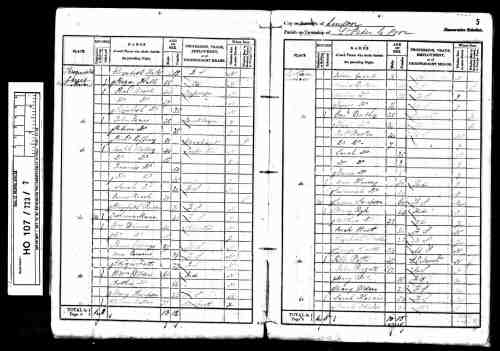William Dimes
- Born: 1790, Bermondsey, London, England
- Marriage (1): Elizabeth Wintersgill Piercy in Sep 1817 in St. Mary, Islington
- Died: 1876, Vallerguis, Alpes Maritime, France at age 86
- BuriedMale: 1876, Cannes, France

 General Notes: General Notes:
Between 1810 and 1815 William was articled to a solicitor, Carter Draper.
In 1816 first appeared in the Law List as a solicitor of 7 Thravies Inn, Holborn.
1817 - 1821 his address was Hatton Garden.
1822 at 10 Bond Court, Walbrook, Shoreditch.
1824 - 1833 at 26 Princes St,Bank. He then stayed at 18 Austin Friars, Broad St for 11 years. In 1846 he re-located his business to 46 Linclns Inn Fields.
In 1848 he was at 20 Pall Mall.
In 1851 he returned to 18 Austin Friars.
In 1856 he moved to 2 New Bond St. He then disappears from the Law List.
The Times newspaper has reports on cases in which he was involved on 26 April 1832, 15 June 1832, 16 December 1833, 16 January 1834, 30 April 1834, 17 May 1842, 28 April 1846, 28 November 1849, 23 July 1851, 26 June 1852. Apart from these he became personally involved in some long running litigation.
In the first of these cases he sued the executors of his father in law's will. They paid dividends to his wife's mother which William thought should have been paid to his wife. The hearings dragged on for 8 years from 1820 to 1828 but William won in the end.
The next case concerned William's purchase of the Manor of Rickmansworth which he bought in about 1815. His land lay alongside the River Colne and he was responsible for repairing the bridge across the river. Having made a good job of rebuilding the bridge in 1833, he sued the owners of the land on the opposite side of the river for their share of the cost, a case he won on appeal in 1835.
In that year another long running dispute started. In 1797, the Grand Junction Canal was built across land in the manor which the canal company had bought from the copyhold tenant Mr Skidmore. Mr Skidmore died in May 1835 and William declared that the use of the land reverted to the Lord of the Manor as Skidmore had no heir. He started an action to eject the canal company which was heard at the Hertford assizes and then at the court of King's Bench. Having confirmed his legal right to the land he put a bar across the canal to stop the boats. The company offered to buy his rights for £3,600 but William demanded £5,500 which they would not pay and they obtained an injunction to prevent him blocking the passage of boats. The company also discovered an heir to Mr Skidmore, a nephew, Edward Lucas, but William refused to admit him as tenant to the land. By 1849 matters were still not settled and William had been employing people to walk along the canal bank to ward off the barges. He was brought back to court for breaching the injunction. At this time, William discovered that the Lord Chancellor, Lord Cottenham, who had confirmed the injunction on appeal, was a shareholder in the Grand Junction Canal Company. William declared this made his judgement invalid. He then had a trench dug across the towing path and put a chain across the canal. This resulted in William being committed to the Queens Bench prison in January 1850 for contempt of court, where he remained until July when he agreed not to block the traffic again. In 1852 the House of Lords agreed that the Lord Chancellor was disqualified from hearing the case but the Vice Chancellor's decrees should stand. He had previously said that he could not alter the Lord Chancellor's decisions. William lost the case and was left with £2,000 debt. He demised the Lordship to his son in 1853 and he sold it in 1857.
The last personal case that William fought concerned the will of his brother Thomas. Details of that will be found with Thomas.
In 1837 William bought the Oldstone estate at Blackawton, South Devon, with its existing £8,000 mortgage. He hardly lived there being mostly in London. When he retired from law he bought a property near Cannes, the Villa Vallerguis, and lived there for the rest of his life. He had some land which was terraced and planted with orange and olive trees and vines. In 1866 his grandson visited him and wrote "My grandfather had a circle of aquaintances of every description and type and the society was very entertaining. His mode of living was rather eccentric. Martin Bannard and his wife Angela and their baby were his only servants. He did most of the cooking himself. - - - He was original and unconventional in his ideas. The most devout families were much concerned about his prospects in the next world and told me so as he was decidedly unorthodox in his views on religious matters."
William died in 1876.
William married Elizabeth Wintersgill Piercy September 1817 at St Mary Islington by licence. Elizabeth was the daughter of Capt John Wintersgill Piercy and Mary. John died 1802 and Mary later married Richard Scott. In 1799 when in Calcutta, Capt John invested £2,000 at £10% in East India Company decennial loan. This was the source of the income which William claimed for his wife. Elizabeth died at Oldstone and was buried at Blackawton in the summer of 1848. On 7 November 1848 William obtained an administration for her estate; goods, chattels and credits amounting to £800.

William married Elizabeth Wintersgill Piercy, daughter of John Wintersgill Piercy and Mary, in Sep 1817 in St. Mary, Islington. (Elizabeth Wintersgill Piercy was born in 1786 and died in 1848 in Kingsbridge.)
|



 General Notes:
General Notes: